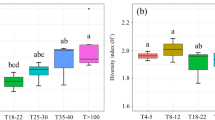Summary
A survey was made of weedy plant species found on distubed sites in Utah. Of the 74 species sampled, 57% were found to contain VA mycorrhizae. Mycorrhizal and nonmycorrhizal species strictly followed taxonomic divisions, regardless of growth habit. Nonmycorrhizal species were members of the Amaranthaceae, Brassicaceae, Capparidaceae, Caryophyllaceae, Chenopodiaceae, Papaveraceae, Polygonaceae, Portulacaceae, Rubiaceae, and Zygophyllaceae.
Cover data were obtained for all plant species, including nonweedy species, colonizing seven of the disturbed sites. Flat semiarid sites were dominated by nonmycorrhizal species. The proportion of mycorrhizal plant cover may be related to water availability. Rocky, sloping sites were dominated by mycorrhizal species. Disturbance by fire did not cause a significant change in the mycorrhizal component of the community.
Similar content being viewed by others
References
Allen EB, Allen MF (1980) Natural re-establishment of vesiculararbuscular mycorrhizae following stripmine reclamation in Wyoming. J Appl Ecol 17:139–147
Daft MJ, Nicolson TH (1974) Arbuscular mycorrhizas in plants colonizing coal wastes in Scotland. New Phytol 73:1129–1138
DeBano LF, Rice RM (1971) Fire in vegetation managementits effect on soil. In: Proc Interdisciplinary aspects of watershed management: A symposium. Bozeman, Montana, August 3, 1971:327–346
Dunn PH, DeBano LF (1977) Fire's effect on the biological and chemical properties of chaparral soils. In: Interdisciplinary symposium on the environmental consequences of fire and fuel management in Mediterranean climate ecosystems (Palo Alto, California; August 1–5, 1977), US Department of Agriculture Forest Service Gen Tech Rep, WO-3, pp 75–84
Gerdemann JW (1968) Vesicular-arbuscular mycorrhiza and plant growth. Ann Rev Phytopathol 6:397–418
Gerdemann JW (1975) Vesicular-arbuscular mycorrhizae. In: Torrey JR, Clarkson DJ (eds), The Development and Function of Roots, Academic Press, London, pp 575–591
Harley JL (1970) The importance of micro-organisms to colonizing plants. Trans Bot Soc Edinburgh 41:65–70
Janos DP (1980) Vesicular-arbuscular mycorrhizae effect lowland tropical rain forest plant growth. Ecology 61:151–162
Jensen IB, Sindelar BW (1979) Permanent stabilization of semiarid roadsides with grass, legume, and shrub seed mixtures and native grass dryland sodding. Montana Agricultural Experiment Station, Montana State Univ Res Rep 141(3)
Khan AG (1978) Vesicular-arbuscular mycorrhizae in plants colonizing black wastes from bituminous coal mining in the Illawarra region of New South Wales. New Phytol 81:57–63
Khan AG (1974) The occurrence of mycorrhizas in halophytes, hydrophytes, and xerophytes, and of Endogene spores in adjacent soilds. J Gen Microbiol 81:7–14
Miller RM (1979) Some occurrences of vesicular-arbuscular mycorrhiza in natural and disturbed ecosystems of the Red Desert. Can J Bot 57:619–623
Moorman T, Reeves FB (1979) The role of endomycorrhizae in revegetation practices in the semi-arid West. II. A bioassay to determine the effect of land disturbance on endomycorrhizal populations. Am J Bot 66:14–18
Nicolson TH (1960) Mycorrhiza in the Gramineae. II. Development of different habitats, particularly sand dunes. Trans Br Mycol Soc 43:132–145
Phillips JM, Hayman DS (1970) Improved procedures for clearing roots and staining parasitic and vesicular-arbuscular mycorrhizal fungi for rapid assessment of infection. Trans Br Mucol Soc 55:158–160
Powell CL (1979) Mycorrhizal infectivity of eroded soils. Soil Biol Biochem 12:247–250
Reeves FB, Wagner D, Moorman T, Kiel J (1979) The role of endomycorrhizae in revegetation practices in the semi-arid West. I. A comparison of incidence of mycorrhizae in severely disturbed vs. natural environments. Am J Bot 66:6–13
Stebbins LG (1965) Discussion of paper by Dr. Stebbins. In: Baker HG, Stebbins CL (eds) The Genetics of Colonizing Species, Academic Press, New York, p 192–195
Trappe JM (1981) Mycorrhizae and productivity of arid and semiarid rangelands. In: Manassah J, Briskey EJ (eds) Advances in Food Producing Systems for Arid and Semi Arid Lands, Academic Press, New York, pp 581–599
Author information
Authors and Affiliations
Additional information
This research was supported by U.S. Department of Agriculture Forest Service, Intermountain Forest and Range Experiment Station, Agreement 12-11-204-31, Supplement No. 25
Rights and permissions
About this article
Cite this article
Pendleton, R.L., Smith, B.N. Vesicular-arbuscular mycorrhizae of weedy and colonizer plant species at disturbed sites in Utah. Oecologia 59, 296–301 (1983). https://doi.org/10.1007/BF00378852
Received:
Issue Date:
DOI: https://doi.org/10.1007/BF00378852




